
V1
COMMISSIONED
1971
MATERIAL
Cast bronze covered in 23 karat gold leaf
HEIGHT
18’ (5.5 Meters
WEIGHT
4,000 lbs. (1814.4 kilograms)
CURRENTLY ON 1 Temple
V2
COMMISSIONED
1978
MATERIAL
Cast bronze covered in gold leaf
HEIGHT
15’ (4.6 Meters)
WEIGHT
4,000 lbs. (1814.4 kilograms)
CURRENTLY ON
3 Temples

Third Moroni, Ensign to the Nations
18 and a half years would pass till the Church put another Angel Moroni on a temple. Between the LA and DC Temples, the Church would erect and dedicate five temples without an angel statue atop them. The third temple to have an angel statue was the massive new temple built in the U.S. Capital, Washington D.C., the 16th operational Temple in the world.
The Competition
For the Salt Lake Temple, President Woodruff was already certain as to who he wanted to make the statue.
For the Los Angeles Temple, Edward Anderson contracted with his friend Millard Malin for the design.
For this new temple, the Church would follow a plan similar to what they had done for the design of the Cardston and Mesa Temples. Specific artists were invited to submit designs in a competition to be considered for the new temple. Designs were to be submitted in the form of clay figures approximately two feet in height. On 10 July 1971, the church announced the selection of the design submitted by Avard Fairbanks.[1]“Angel Moroni Statue Chosen For Temple,” Deseret News, 10 July 1971.
Sculpting the Statue
Avard sculpted the larger than life, 18-foot copy of the statue in Pietrasanta, Italy. Fairbanks invited all the temple Architects to come and examine the statue on site. Each of the Architects and their families took him up on the offer in turn. When Keith Wilcox, Chief Architect for the temple stopped by, he told Brother Fairbanks that he did not like the statue. Brother Fairbanks was concerned, until Brother Wilcox explained the mouth on the statue did not look right. He explained that the mouth appeared to be drinking from the trumpet, rather than blowing into it. Brother Wilcox explained to Avard how a trumpet player purses their lips together, and adjusted the pressure in his lips to change the note. He then demonstrated, puffing out his cheeks and pursing his lips. Avard got excited and asked Brother Wilcox to hold the pose, which he did, for the next 45 minutes.
Brother Wilcox was rather proud of having modeled for the Moroni statue, and by his own account worked it into conversations whenever he could. The excitement lasted until the statue was installed. At that point he realized that he could barely see the head on the statue, let alone how the lips were configured.[2]Wilcox, Keith Wilson 1921-; Wilcox, Keith Wilson 1921-2011. A personal testimony concerning the Washington Temple / Keith W. Wilcox [Ogden, Utah?]: The Author, c1995 5th printing.
Once the full-scale statue was completed, it was converted to plaster molds and was cast in bronze in Italy near where it was sculpted. Fairbanks would often go to Pietrasanta to finish marble works he was commissioned for,[refFairbanks, Eugene, “Sculptural Commemorations of Abraham Lincoln by Avard T. Fairbanks” Journal of the Abraham Lincoln Association, Vol 26, Issue 2, Summer 2005, p. 46-47.[/ref][3] Fairbanks, Eugene, “THE LIFE AND WORK OF AVARD TENNYSON FAIRBANKS, BFA, MFA, MA, PhD, DFA, hon. Sculptor Anatomist, and Educator,” Traditional Fine Arts Organization, Inc., 2006. and had others of his bronze works cast there as well.[4]“Poney Express, (sculpture.) Smithsonian.
Design
The statue is a graceful figure that presents a feeling of power and strength. Of his design Doctor Fairbanks said:
“I wanted the statue to conform to the spirit and architecture of the temple, that of aspiring upward. I wanted the feeling of that upward reach accomplished by the stress of vertical lines. I thought of the Angel Moroni coming to the world to herald the advent of the latter days and bringing the gospel plan to the people of today.”[5]“Angel Moroni Statue Placed on Spire of Washington Temple,” Ensign, July 1973.
Avard Fairbanks’s Angel Moroni is the only temple statue that has the trumpet pointing the same direction as the feet. All other statues have the trumpet and head turned at an angle to the right of the chest and feet.
Like Malin’s Moroni, this angel holds a reproduction of the Gold Plates that the Book of Mormon was translated from nestled in the crook of his left arm. The robes on Fairbanks’s Moroni are long, longer than on any other Moroni. They spread across part of the feet, well below the ankles. Most Moroni Statues have the robes end about or above the ankles.
This statue was also the first to be used on more than one temple. Originally, just an 18-foot statue (from feet to crown) for the Washington DC Temple was commissioned. Later three 15-foot versions were made to be used on other temples. The Washington DC statue is still the tallest Angel Moroni in use when measured from feet to crown.
The bronze does not suffer the pitting problem of the Aluminum statue; however, the bronze can suffer corrosion issues, especially in areas with a high acid content in the rain.
Placement
The completed and gold leafed statue was placed atop the easternmost spire 11 May of 1973. Avard Fairbanks was on hand for the placing of the statue, as was Elder Thomas S. Monson, then one of the twelve apostles. He was joined by Elder Boyd K. Packer. Sister Ina Jane Ashton Richards, Elder LeGrand Richards wife was there for the occasion as well, as she happened to be in town at the time. [6]“Angel Moroni Statue Placed on Spire of Washington Temple,” Ensign, July 1973.
[gphotos type=”rectangular” ids=”7786″]
This statue was only the third statue to be placed on any temple in 81 years. It was, and still is, the largest. [7]“Angel Moroni Statue Placed on Spire of Washington Temple,” Ensign, July 1973. Besides the three temple statues, only two other angel statues were in use by the Church at this time. The first was a statue by Torleif Knaphus sculpted for the Washington D.C. Chapel, which would soon be removed when the church would sell the building. The second, also by Knaphus, was the statue on the Hill Cumorah Monument.
The Last of the Old Guard
The Commission
[8]Young, Richard, Personal Interview with Brian Olson and Marvin Quist, 10 July 2018. The remainder of this section comes from an extensive personal interview with Richard Young, who assisted Avard Fairbanks in the creation of the 3 smaller Angel Moroni Statues.In the 1970’s the Church did something it had never done before: They commissioned multiple copies of a single statue for placement on multiple temples. Prior temples had each received a custom sculpted and crafted statue made just for that temple. And there were only three temples with a statue, Salt Lake, Los Angeles, and Washington D.C.. However, the church was in the early stages of a program to increase temple construction.
Five new temples were being planned: Sao Paulo Brazil, Tokyo Japan and Seattle Washington Temples were all announced in 1975; Mexico City was announced in 1976; and Jordan River was announced in 1978. The latter 3 of these new temples were each planned to have an Angel Moroni Statue.
[gphotos type=”rectangular” ids=”7495″]
To fulfill this plan, The Church contacted Dr. Avard Fairbanks and Richard Young of Young Fine Art Casting Studio. The two of them were commissioned to create a shorter, 15-foot replica of Avard’s previous statue, the last Angel Moroni to have been placed on a temple. Other than size, this was to be identical to the 18-foot statue which he had sculpted for the Washington D. C. Temple.
Young and Fairbanks were convinced that their statue would be a new standard to be used on multiple temples moving forward. They created their new statue in a manner that would allow them to cast statues over again from a single mold.
The Method
To produce the resized statue, they first constructed a skeletal frame out of wood in the approximate shape of the sculpture. The basic form of the statue was then created over the top of the frame with chicken wire. 3 inches of water clay was then placed over the top of the chicken wire to sculpt the details into. They used rulers, tape measures, and a calculator to resize details of Fairbank’s original maquette up to the size of the new 15-foot sculpture framework. The formula used to resize the dimensions of the maquette to the dimensions of the statue was based upon the ratio of the maquette height to the statue height.
When sculpting of the new statue was complete, deep relief features on the statue were covered in a rubber shell known as a case. Then the whole thing, rubber case and all, was covered in a plaster case. This
new shell, once hardened, was cut into multiple pieces and removed, becoming the new mold. The rubber case on the deep relief areas could be easily bent to seperate it from the statue while still allowing the mold to retain its shape.
Sections of the mold would then be pieced together like a puzzle and the inside of the partial mold would be coated with molten bronze up to 1/4 thick. Once the bronze had cooled and set, the metal pieces could be removed and welded together into the new statue.
[gphotos type=”rectangular” ids=”6257″]
Research on the three statues made from this method often return wildly differing numbers as to how much the statues each weigh. Most of the weight of the statue would come from the skeletal structure, typically made of stainless steel, rather than from the bronze shell. Because this interior structure could vary, the weight of the statue could vary as well.
Silicon bushings were used between the steel framework and the bronze shell to prevent corrosion from electrolysis between the dissimilar metals. The weight of the overall statue was mostly from the interior support, with less than half the weight coming from the actual bronze. The materials for the internal support were chosen by the Church, based on the structure of the spire for the temple the statue would be attached to. As such, each of these three statues has a different weight.
During this whole process, a younger man by the name of Karl Quilter was very interested in the process and procedure they were developing. He would often come to watch, assist, and learn from Richard Young and his college instructor, Dr. Avard Fairbanks.
The End of an Era
The first of these new, mass-produced statues, was placed atop the Seattle Washington Temple on 25 October 1979.[ref Hansen, Lynne Hollstein, “Much publicity given Seattle Temple events,” Church News, 3 November 1979, p. 12. [/ref] The second was placed on the Jordan River Utah Temple on 7 August 1981.[9]“Sneak preview of statue,” Church News, 15 August 1981, p. 9.
For Young and Fairbanks, they believed this was the beginning of what they would be doing for the rest of their lives. Clearly the Church was planning soon to build even more temples all over the world. In just a couple of years the Church would indeed announce first 7 and then another 9 new temples to be built world-wide.[10]Young, Richard, Personal Interview with Brian Olson and Marvin Quist, 10 July 2018.
However, these new temples were actually initially designed to have neither spire nor angel. When spires were added, they were thin narrow spires unable to bear the weight of the massive metal statues. The Church would seek out an innovative, new method for statues, and so the first three of these new “standard statues” would also be the last three.
[gphotos type=”rectangular” ids=”6610″]
The final of these statues was placed atop the Mexico City Mexico Temple in September of 1982. By that time, the first of the new light-weight statues had already been atop the Atlanta Georgia Temple for a month. To date, The Mexico City Statue was the last metal statue ever placed atop a temple.
Identification Guide
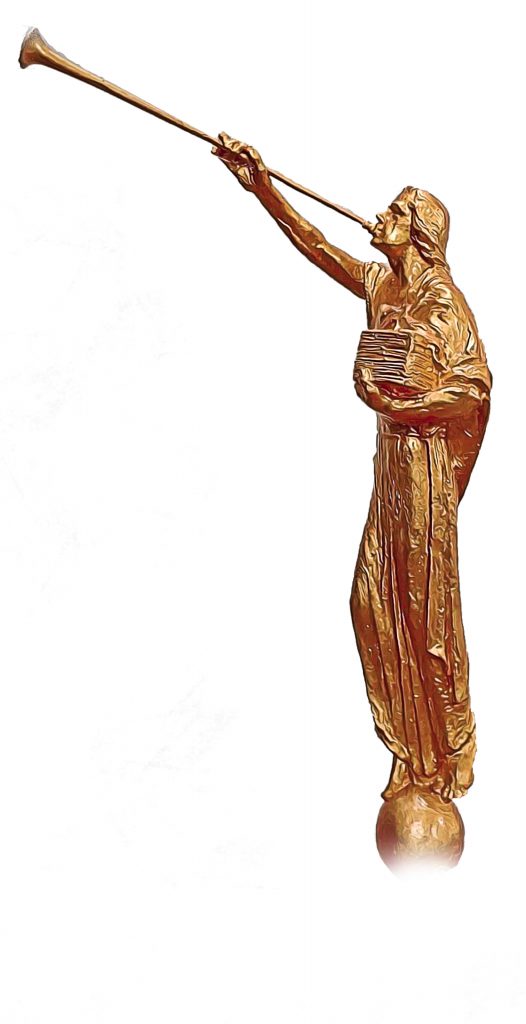
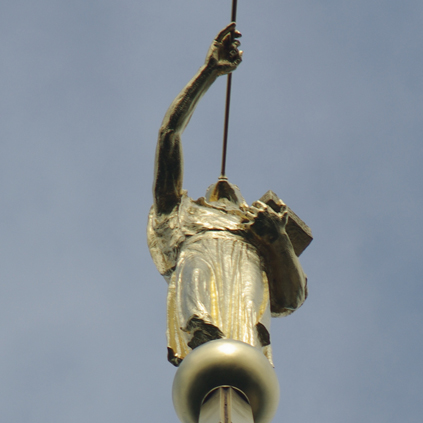
Direction
This is the only Angel Moroni Statue that has the trumpet pointing the same direction as the feet. All other statues have the trumpet and head turned at an angle to the right from the chest and feet.
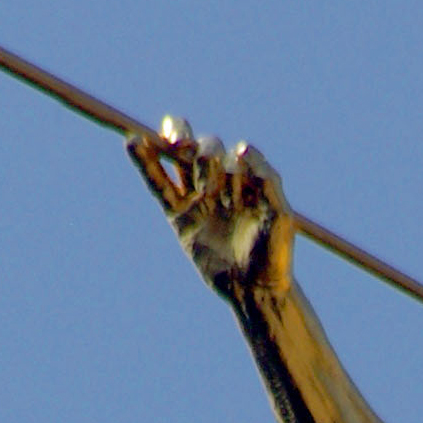
Loose Grip
The left hand on the Fairbanks statue holds the trumpet in a loose grip, the fingers extended and the pinky under the trumpet instead of over.
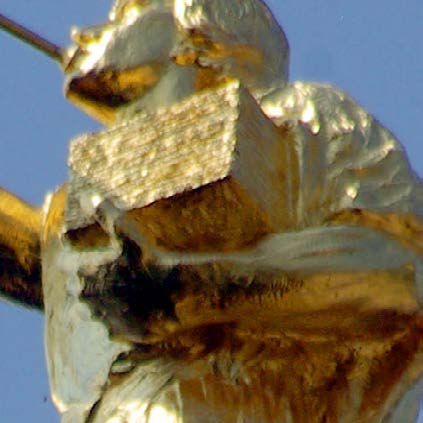
Gold Plates
Like the Los Angeles Moroni, this Angel Moroni holds a reproduction of the Gold plates that the Book of Mormon was translated from nestled in the crook of his left arm.
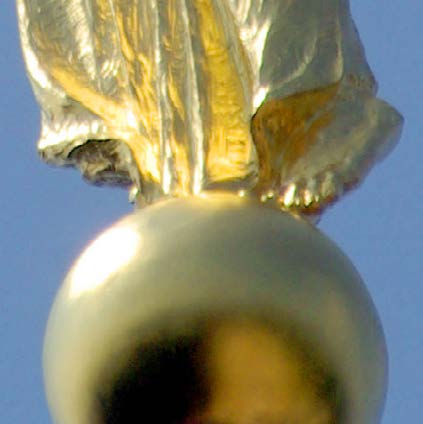
Below the Ankles
The robes on this Angel Moroni are so long they cover part of the feet. Most Moroni Statues have the robes coming to at or above the ankles.
Chapter 3 Navigation
Related Articles
Avard Fairbanks →
Rough Beginnings For Seattle →
Another Angel Flying →
Foiled Unveiling →
Myth 6 | Moroni and Mexico City →
References
| ↑1 | “Angel Moroni Statue Chosen For Temple,” Deseret News, 10 July 1971. |
|---|---|
| ↑2 | Wilcox, Keith Wilson 1921-; Wilcox, Keith Wilson 1921-2011. A personal testimony concerning the Washington Temple / Keith W. Wilcox [Ogden, Utah?]: The Author, c1995 5th printing. |
| ↑3 | Fairbanks, Eugene, “THE LIFE AND WORK OF AVARD TENNYSON FAIRBANKS, BFA, MFA, MA, PhD, DFA, hon. Sculptor Anatomist, and Educator,” Traditional Fine Arts Organization, Inc., 2006. |
| ↑4 | “Poney Express, (sculpture.) Smithsonian. |
| ↑5, ↑6, ↑7 | “Angel Moroni Statue Placed on Spire of Washington Temple,” Ensign, July 1973. |
| ↑8 | Young, Richard, Personal Interview with Brian Olson and Marvin Quist, 10 July 2018. The remainder of this section comes from an extensive personal interview with Richard Young, who assisted Avard Fairbanks in the creation of the 3 smaller Angel Moroni Statues. |
| ↑9 | “Sneak preview of statue,” Church News, 15 August 1981, p. 9. |
| ↑10 | Young, Richard, Personal Interview with Brian Olson and Marvin Quist, 10 July 2018. |
